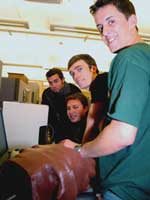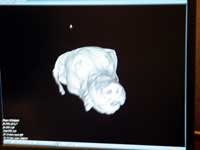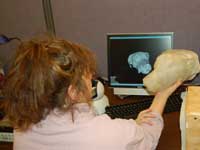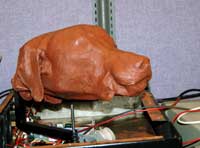SimPooch: An Alternative to Animal Use in Veterinary Curriculum
 |
|
SimPooch Senior Design Team
|
The medical practice of acupuncture originated in China more than 2,000 years ago. One of the oldest and most commonly used medical procedures in the world, acupuncture was first taught using bronze statues dappled with small holes representing accurate acupuncture points. Filled with water, mercury or other substances, then coated in wax to contain the liquid, the statue would simulate "bloodletting" when acupuncture points were accurately targeted. Today acupuncture is currently taught using live subjects and trial and error methodology.
Introduced to America in the 70's, acupuncture is now not only a widely practiced form of alternative medicine in humans, but is growing in popularity among pet owners. Although still widely considered an energy-based form of medicine by many in the West, acupuncture actually works by stimulating the nervous system. Therefore, the relationship of nerves to acupuncture points is crucial to grasp, and learning the correct location of these points requires in-depth anatomic knowledge.
Senior electrical and computer engineering students are addressing this growing need for suitable, anatomically oriented teaching models, in the veterinary acupuncture curriculum. SimPooch, a three-dimensional canine head prototype, will allow educators to target acupuncture points beforehand on a physical model that will serve to later assess students' precision and accuracy in identifying the same points by means of computer software. Students Ben Cordova, Jeff Bartlett, Brendan Dahl and Eric Hall are working on the medical tool under the direction of project adviser Dr. Peter Young, professor of electrical and computer engineering, and project sponsor Dr. Narda Robinson, DO, DVM, MS, FAAMA, who serves as the Shipley Professor in Complementary and Alternative Medicine as well as the Director of the Center for Comparative and Integrative Pain at Colorado State.
"SimPooch is a one-of-a-kind endeavor. To the best of our knowledge, no other anatomically-driven canine models exist that were created from MRI data specifically for the purpose of acupuncture education," notes Dr. Robinson. "Once we refine this model, its applications extend to other disciplines within veterinary medicine, and the techniques can be extrapolated to develop human models for medical school instruction. The interface designed by these student engineers is fascinating and fun. I am extremely pleased with the dedication and scholarship of these young professionals."
A multidisciplinary endeavor, the project originated within mechanical engineering under the direction of the Director of the new School of Biomedical Engineering, Dr. Sue James. Mechanical senior design students developed a three-dimensional canine cranium from MRI imaging of normal dogs with materials of different densities, designed to simulate the densities of fat, muscle and bone. The team then covered the hard skull prototype with a silicone compound to resemble a canine head.
 Three-dimensional dog model |
 Dr. Narda Robinson |
 Physical dog model |
Presently, electrical and computer engineering students are developing software to assess accuracy and precision of student acupuncture technique through three-dimensional coordinate acquisition. Serving as the needle, a robotic device, the PHANTOM® haptic interface, will allow users to identify acupuncture points on a physical canine head while simultaneously interacting with an onscreen virtual reality space. A complex environment to simulate, the canine head has approximately 3,000,000 points in three-dimensions. Students first created a virtual fish, with only 3,000 points, to serve as a model for such complicated environments.
Future goals include the measurement of position and force, an additional variable integrating dog flesh properties into the system by using the haptic device to restrict motion after contact, much like a needle in actual flesh.
According to Dr. Young, "The current software under development by the SimPooch student team will allow for precise repeatable 3D position trials, with accurate measurement of the trainee versus expert performance, which will provide an invaluable teaching tool. However, the full vision of this approach goes much further than that. The haptic interface allows us to 'display' forces in the same way that a monitor displays images. Thus our ultimate goals include developing accurate 3D simulations of an acupuncture trial, including the 'feeling' of getting it right/wrong, all done in a virtual environment without the use of actual patients. In this way we hope to significantly improve the amount and efficacy of acupuncture training available."
Other objectives include the solidification of the MRI-to-model process, and the application to different dog breeds, and eventually to humans. Researchers hope in the future, haptic technology can be used for human medical simulations including interventional radiology, oncology biopsies, lumbar punctures, spinal taps, force feedback of ligament penetrations and addressing nerve blocks.
By reinforcing anatomical concepts, and eliminating subjective assessment and bias, SimPooch may contribute to board certification in acupuncture. Not only a reproducible teaching method, SimPooch will also serve to diminish animal pain and discomfort by reducing the number of animals needed in teaching scenarios. With the capability to interface with a model using virtual correspondence and force feedback, SimPooch technology will address veterinary acupuncture from a scientific, rational, and evidence-based standpoint.
Additional Information
For more information on SimPooch visit http://www.engr.colostate.edu/ece-sr-design/AY07/SimPooch/index.htm
For more information on the Electrical and Computer Engineering Senior Design Program visit http://www.engr.colostate.edu/ece/current_students/senior_design_program.shtml